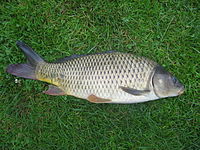
Photo from wikipedia
The introduction of Common Carp (Cyprinus carpio) into North American waterways has led to widespread alteration of aquatic ecosystems. Control of this invader has proven extremely difficult due to its… Click to show full abstract
The introduction of Common Carp (Cyprinus carpio) into North American waterways has led to widespread alteration of aquatic ecosystems. Control of this invader has proven extremely difficult due to its capacity for rapid population growth. To help understand how Common Carp can potentially be controlled we developed a population dynamics model (CarpMOD) to explore the efficacy of active and passive control measures that impose mortality on multiple life stages (embryos, juveniles and adults). We applied CarpMOD to Common Carp in Malheur Lake, a large shallow lake in Southeast Oregon, USA. Simulated control measures included commercial harvest of adults, trapping of juveniles, embryo electroshocking, and passive removal imposed via avian predation. Results from CarpMOD suggest that no single active removal method would decrease Common Carp biomass below the targeted 50 kg/ha threshold. Combinations of two or all three active removal methods could, however, reduce biomass below the desired threshold due to cumulative mortality on multiple life stages. CarpMOD simulations suggest that the level of carp removal necessary to reach the desired biomass threshold is approximately 40% at each life-stage, which may be unrealistic to maintain over longer time scales. Passive removal via avian predation may also contribute to suppression of Common Carp, but was not sufficient in isolation to reduce biomass below the desired threshold. Collectively, our results indicate control of Common Carp as a sole means of ecosystem restoration is unlikely to be effective in the system we modeled. This suggests additional means of restoration may be warranted, perhaps in combination with control of Common Carp, or development of more effective control measures.
Journal Title: Wetlands Ecology and Management
Year Published: 2019
Link to full text (if available)
Share on Social Media: Sign Up to like & get
recommendations!